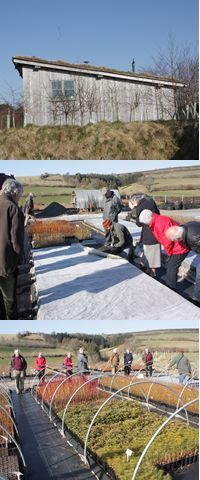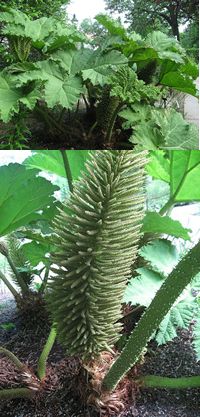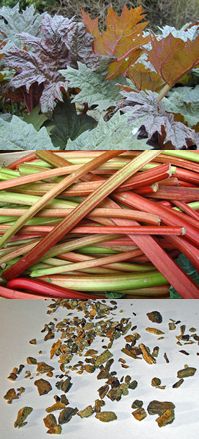In March the Group visited the Exmoor area for a weekend of talks and visits to nurseries and gardens. Much of this visit was reported in last months Newsletter but an interesting visit to tree producer Exmoor Trees is reported below.
At the end of April the Group visited Hardy's Cottage Garden Plants and the Bombay Sapphire Gin company - to study the plants used to flavour the gin of course.
13 April saw the closing date for entries to this year's David Miller Travel Bursary Award. A total of 18 entries were received and these are currently being judged.
In May we will be visiting the Gardens of Belcombe Court, Bradford on Avon and the nearby Evolution Plants on 12 May. In addition the Cambridge and Eastern Group have organised their annual visit to the Cambridge Botanic Gardens on 14 May.
18 May is Fascination of Plants Day with events organised around the country.
Peter Grimbly
Contents
High level tree production
Plant of the Month
Medicinal Plant of the Month
News from our Associates
Horticulture Industry News
Events Calendar
Horticulture Group contact details
Related Links
High level tree production
At first sight it would seem that UK tree producers are at a disadvantage to their continental cousins who, with warmer summers, can get much more growth on their plants each year. However, experience gained helping UK producers sell their trees at European trade shows proves this is not the disadvantage it seems. Our cooler summers produce shorter internodes, closer branching and an altogether sturdier tree which is much sought after.
Tim Goodland has chosen to take this advantage to a slight extreme by setting his business, Exmoor Trees, 1000ft above sea level in the centre of Exmoor. Our visit started in the 'potting shed', a building Tim had built by hand with a timber frame and straw walls clad again in timber. In keeping with the green recycling philosophy the straw walls are supported on old tyres and the structure supports a green turf roof (picture top right).
Tim grows his trees from locally sourced seed wherever possible. Sadly last year there had been no sessile oak seed in the country so it was necessary to buy in from abroad. Smaller seeds are started in seed trays and planted out in cell trays in the spring. Larger seeds are sown and germinated directly in the cell trays which are laid on sand beds to provide irrigation. He uses a standard Melcourt silvermix compost augmented with osmocote slow release fertiliser. Depending on the reliability of the seed he will sow several seeds per cell aiming to thin out after germination.
The 21 sand beds are independently irrigated as creating a completely level site had proved too expensive. However, Tim had got round this problem with an ingenious plug-in system based on a pheasant feeder to enable each bed to be filled to the correct level with a minimum of effort. The beds are covered with permeable mats incorporating a copper coating to restrict root penetration. The trays, once laid out on the beds, are covered in fleece to hold in moisture during germination (picture centre right) and can also be covered with fleece cloches in very cold winter weather to protect the more tender species such as hornbeam. Shade netting is also used for summer cooling.
The nursery was reasonably well protected from the main tree predators such as deer and rabbits but some smaller rodents, probably voles, were causing problems 'felling' year-old seedling by biting through just above ground level.
The nursery grows a wide variety of native trees and hedging species and the majority is sold in the local area.
Tim has also established his own wood which proved a surprise to those of us who had done our homework on Google Earth. The site that looked seemingly flat from an aerial perspective proved to have a near 45 degree slope. Nevertheless the wide selection of four-year old native trees had for the most part established well and should produce a valuable woodland in years to come on an otherwise difficult site.
Plant of the Month
Gunnera manicata, giant rhubarb, Gunneraceae
With the common name of giant rhubarb it doesn’t take much imagination to know what this plant looks like. With some of the biggest leaves in the plant world (picture upper right by Dezidor), the inclusion of the word giant in the common name is indeed accurate. And although the petioles can be eaten, it is certainly not a rhubarb.
This genus was named for Johan Ernst Gunnerus, a Norwegian bishop (at Trondheim) and botanist who lived from1718 to 1773. He was the author of Flora Norvegica (1766-1772). The specific epithet, manicata, means with long sleeves.
There are 40 species of Gunnera, growing widely through tropical and southern Africa, Malesia, Tasmania, New Zealand, Antarctic islands, Hawaii, and South America. This species originates from the Serra do Mar mountains of south-eastern Brazil.
Although not fully hardy in the UK, Gunnera manicata is grown successfully in sheltered sites. It is over-wintered by protecting the crown with upturned leaves cut off in the autumn. If you want to see what happens when a team of horticulturists put Gunnera 'to bed' for the winter, have a look at the @OBGHA twitter feed from October 2013. There's some great pictures!
Now, in late spring/early summer the cycle of growth begins again with the giant leaves unfurling and the magnificent but unearthly flower spikes emerge.
Unlike the Rheum species discussed below, relatively little is known about the chemical constituents of Gunnera manicata. Brazilian researchers have however begun to investigate its anti-microbial properties. What is known is that the stems and adventitious roots are home to symbiotic microorganisms such as Nostoc punctiforme (See Plant of the Month for February 2015) a nitrogen-fixing cyanobacteria. The cyanobacteria produces a toxic amino acid, beta methyl amino alanine (BMAA).
Picture lower right: The flowers of Gunnera manicata by Dezidor
Further reading:
Chemical constituents and pharmacological profile of Gunnera manicata L. extracts.
Braz. J. Pharm. Sci. vol.50 no.1 São Paulo Jan/Mar 2014
Medicinal Plant of the Month
Rheum palmatum, rhubarb, Polygonaceae
At this time of year, in gardens and allotments across the country, those juicy pink stems of rhubarb are growing strongly. Thoughts turn to rhubarb crumbles, rhubarb chutneys, jams and other edible delights. The rhubarb we grow for eating include a number of domesticated varieties recognised as Rheum x hybridum by the Royal Horticultural Society. The petioles (leaf stems) are edible, but the leaves contain oxalic acid, rendering them toxic to humans.
There are 30 species of Rheum originating across Europe, temperate and warm Asia. This species originating in North-western China and Tibet. The rhubarb plant is a veritable chemical factory producing lots of interesting molecules – some of which are medicinally useful.
Historically it has been the root of the rhubarb plant that is used medicinally. The root contains a large and variable number of hydroxyanthracene derivatives, most of which are present as anthraquinone (anthrone) glycosides of the main aglycones including chrysophanol and chrysarobin. The root is made into a powder which has been used as a treatment for both diarrhoea and constipation (in different doses). However, dithranol, an anthrone of very similar chemical structure to both chrysophanol and chrysarobin is used as a treatment for psoriasis. It acts by interfering with the energy supply to cells thus slowing down the excessive cell division that occurs in psoriatic plaques.
For the ornamental garden, Rheum palmatum 'Atrosanguineum' is a striking addition if you have a large enough space. With a height and spread of 2m this clump forming perennial has very large, deeply cut lobed leaves that are a dark red when young. The crimson flowers are borne in large fluffy panicles in early summer.
Pictures:
Upper: Rheum palmatum by Wayne Boucher
Middle: https: Rhubarb sticks by Jeremy Keith
https: Rhei radix (chopped rhubarb roots used as a herbal medicine) by Rillke

Alison Foster
News from our Associates
Commercial Horticultural Association
Following a successful spring taking groups to IPM Essen and Fruit Logistica the CHA is now preparing for a busy Autumn. They will be taking groups to three shows; the Naivasha Horticultural Fair in Kenya between 18-19 September 2015; The International Horticultural Trade Fair at Vijfhuizen, Holland between 4-6 November 2015; Growtech Eurasia in Antalya, Turkey between 2-5 December 2015. Grants will be available for eligible UK companies wishing to partcipate and anyone interested should contact CHA.
Society of Biology
The Society gave a detailed response to the review of the Research Councils, led by Paul Nurse. Key to this response was the need to address interdisciplinary and cross-disciplinary research.
UK Plant Science Federation
Last month saw the Federation's annual Plant Science conference, UK PlantSci, held this year at Harper Adams; a location synonymous with agriculture, not only by location, but, for those who have been there, also by smell - apparently the air-conditioning fed air from the cattle pens into the conference hall! Highlights of the conference can be found here. This month will see the third Fascination of Plants Day, a nationwide celebration of plants, to be held at many locations on or around 18 May. Fascination of Plants Day is organised under the umbrella of the European Plant Science Organisation (EPSO) to encourage people around the world to celebrate the importance of plant science.
Horticulture Industry News
For the very latest horticultural news follow us on Facebook,
Twitter, or
LinkedIn
Sweet potato is a natural GMO
Sweet potatoes from all over the world naturally contain genes from the bacterium Agrobacterium. Because of the presence of this 'foreign' DNA, sweet potato can be seen as a 'natural gmo'. Researchers discovered the foreign DNA sequences of Agrobacterium while searching the genome of sweet potato for viral diseases. Instead of contributing this peculiar finding to bacterial contamination of the plant samples, the researchers decided to study these sequences in more detail. The sequences appeared to be present in each of the 291 tested sweet potato cultivars and even in some wild related species. Different research methods confirmed the same conclusion: the specific sequences are not due to contamination, but they are part of the sweet potato genome. The genes in the foreign DNA sequences were also shown to be active in sweet potato, which can indicate that they provide a positive characteristic which was selected for by the farmers during domestication.
Cochineal insects as a biocontrol
Hope beckons for Kenyan farmers after a leading wildlife conservancy announced it would release the sap-sucking cochineal insects to help eradicate a species of cactus blamed for livestock deaths. Cochineal feeds solely on Opuntia stricta, a species of cactus plant which threatens livelihoods because it decimates pasture land through colonising the land. The cochineal insects were imported from South Africa and were quarantined at the Kenya Agricultural Research Institute, through approval from the Kenya Plant Health Inspectorate Services. Additional trials have confirmed that the insects do not pose any threat to native or introduced crops in Kenya. More
Joined-up planning needed to protect UK food and water supplies
The UK needs to formulate long-term plans to protect both water and food supplies here and across international supply chains, as water usage and availability change in coming years. That’s the conclusion in a new report from an expert group, led by the Global Food Security programme as part of the UK Water Research and Innovation Partnership (UKWRIP). Farming and Water: Facing the Future Together (PDF 1.63Mb) was written by a collaboration of scientists, policy experts and specialists from the water industry. Agriculture, food and water supplies are more intimately connected than is often appreciated. As demand for both food and water increases, there is a growing need to recognise the inter-connections and integrate long-term planning for the 'agri-water' system rather than thinking about water and food systems separately. More
Researchers discover gene that controls melting point of cocoa butter
The discovery of a gene involved in determining the melting point of cocoa butter - a critical attribute of the substance widely used in foods and pharmaceuticals - will likely lead to new and improved products, according to researchers. The finding by plant geneticists also should lead to new varieties of the cocoa plant that could extend the climate and soil-nutrient range for growing the crop and increase the value of its yield, they said, providing a boost to farmers' incomes in the cocoa-growing regions of the world. Cacao. More
Champagne owes a debt to ancient viruses
Next time you pour a glass of champagne, raise a toast to the 30-million-year-old viruses that have contributed to the genetic make-up of modern grapes. A team of scientists has discovered that the Pinot Noir grape variety used to produce champagne and other wines owes a significant part of its genetic heritage to ancient plant viruses. The scientists mapped the presence of 30-million-year-old viruses in Pinot Noir DNA. More
Old remedy for modern superbugs
A one thousand year old Anglo-Saxon remedy for eye infections which originates from a manuscript in the British Library has been found to kill the modern-day superbug MRSA in an unusual research collaboration. An Anglo-Saxon expert has enlisted the help of microbiologists to recreate a 10th century potion for eye infections from Bald's Leechbook an Old English leatherbound volume in the British Library, to see if it really works as an antibacterial remedy. Early results on the 'potion', tested in vitro and backed up by mouse model tests are, in the words of one collaborator, 'astonishing'. The solution has had remarkable effects on Methicillin-resistant Staphylococcus aureus (MRSA) which is one of the most antibiotic-resistant bugs costing modern health services billions. More
Expand Neonicotinoid debate beyond bees…
A focus on honey bees has distorted the debate around neonicotinoids. But there is more and more evidence that widespread use of neonicotinoids has severe effects on a range of organisms that provide ecosystem services like pollination and natural pest control, as well as on biodiversity. These are the main conclusions of a new report published today by the European Science Academies (EASAC). Public and political attention has focused on whether honey bee colonies are being affected by neonicotinoids. But studying honey bee colony numbers does not show what is happening to the many other species providing the ecosystem services of pollination, natural pest control, soil productivity or the underpinning of biodiversity. Honey bees are just one pollinator - others include bumble bees, solitary bees, hoverflies, butterflies and moths. Other pollinators have generally declined across Europe as honey bee colony numbers have fluctuated.
.. anyway bees prefer nectar containing nictotine
Bees are attracted to nectar containing common pesticides, scientists. This could increase their chances of exposure to high levels of pesticides. Previous studies have suggested that exposure of this kind can affect bees’ fitness. The research discovered that buff-tailed bumblebees and honeybees could not taste the three most commonly used neonicotinoid pesticides and so did not avoid them. In fact, the bees showed a preference for food which contained pesticides: when the bees were given a choice between sugar solution, and sugar solution containing neonicotinoids, they chose the neonicotinoid-laced food. The lab-based study also showed that the bumblebees ate more of the food containing pesticides than the honeybees, and so were exposed to higher doses of toxins.
Events Calendar
Other Events of Interest:
Quality Management in Supply Chains of Ornamentals
1 - 4 May 2015, International Society for Horticultural Science
Kermanshah, Iran
Environmental protection in a multi-stressed world: challenges for science, industry and regulators
3 - 7 May 2015, Society of Environmental Toxicology and Chemistry
Barcelona, Spain
New strategies to grow consumption of fresh vegetables in Europe
6 - 7 May 2015, Eurofruit & FPJ & Fruchthandel
Brussels, Belgium
Ecologically Sound Fertilization Strategies for Field Vegetable Production
18 - 22 May 2015, International Society for Horticultural Science
Beijing, China
Edible Alliaceae
21 - 25 May 2015, International Society for Horticultural Science
Nigde, Turkey
Valuing long-term sites and experiments for agriculture and ecology
27 - 28 May 2015, Association of Applied Biologists
Newcastle, UK
Horticultural Economics and Management
31 May - 3 Jun 2015, International Society for Horticultural Science
Alnarp, Sweden
Ephemeroptera and Plecoptera
31 May - 5 Jun 2015, James Hutton Intitute
Aberdeen, UK
Durian and Other Humid Tropical Fruits
2 - 4 Jun 2015, International Society for Horticultural Science
Chantaburi, Thailand
Modelling in Fruit Research and Orchard Management
2 - 5 Jun 2015, International Society for Horticultural Science
Montpellier, France
Postharvest Pathology: Using Science to Increase Food Availability
7 - 11 Jun 2015, International Society for Horticultural Science
Bari, Italy
Irrigation of Horticultural Crops
8 - 11 Jun 2015, International Society for Horticultural Science
Lleida, Spain
Innovation in Integrated and Organic Horticulture
8 - 12 Jun 2015, International Society for Horticultural Science
Avignon, France
Bacterial Canker of Kiwifruit
10 - 13 Jun 2015, International Society for Horticultural Science
Bologna, Italy
Fruit Breeding and Genetics
14 - 18 Jun 2015, International Society for Horticultural Science
Bologna, Italy
Plant Biotechnology: Green for Good III
15 - 18 Jun 2015, The European Federation of Biotechnology
Olomouc, Czech Republic
The genomes of forest trees: new frontiers of forest biology
16 - 17 Jun 2015, New Phytologist Trust
Boston, USA
Rubus and Ribes
21 - 24 Jun 2015, International Society for Horticultural Science
Asheville, USA
The quest for tolerant varieties - Phenotyping at plant and cellular level
22 - 24 Jun 2015, European Cooperation in Science and Technology
Gatersleben, Germany
Cucurbits
22 - 26 Jun 2015, International Society for Horticultural Science
Cartagena, Spain
Ornamentals
28 June - 2 Jul 2015, International Society for Horticultural Science
Melle, Belgium
Apricot Breeding and Culture
29 June - 3 Jul 2015, International Society for Horticultural Science
Shenyang City, China
Hydroponics and Aquaponics at the Gold Coast
5 - 8 Jul 2015, International Society for Horticultural Science
Jupiter's Gold Coast, Australia
Arabidopsis Research
5 - 9 Jul 2015, Le Public Système
Paris, France
Ecology and Evolution of Emerging Plant Pests and Pathogens
13 - 14 Jul 2015, British Ecological Society
Exeter, UK
High Value Chemicals from Plants
13 - 14 Jul 2015, BBSRC & University of York
Norwich, UK
Food security: global priorities and the UK's role
14 Jul 2015, Westminster Forum Projects
London, UK
Soil Biodiversity: How to Explore and Utilise Life in Soils?
16 Jul 2015, Rothamsted Research
Harpenden, UK
New Technologies and Management for Greenhouses
19 - 23 Jul 2015, International Society for Horticultural Science
Evora, Portugal
Science and plants for people
25 - 29 Jul 2015, Botanical Society of America
Edmonton, Canada
Plant Biology
26 - 30 Jul 2015, American Society of Plant Biologists
Minnesota, USA
Vineyard Mechanization and Grape and Wine Quality
26 - 29 Jul 2015, International Society for Horticultural Science
Fredonia, USA
If you would like to advertise a forthcoming event please contact. ester.monfort@soci.org
Horticulture Group Contact Details
For submitting ideas or to volunteer to be part of a committee or a group, please contact:
Chairman - Peter Grimbly
Meetings Secretary - Alison Foster
Minutes Secretary - Margaret Waddy
Newsletter co-ordinator - Sue Grimbly scihortigroup@btinternet.com
Group Contact - Ester Monfort Martinez, E: ester.monfort@soci.org T: +44(0)20 7598 1584






